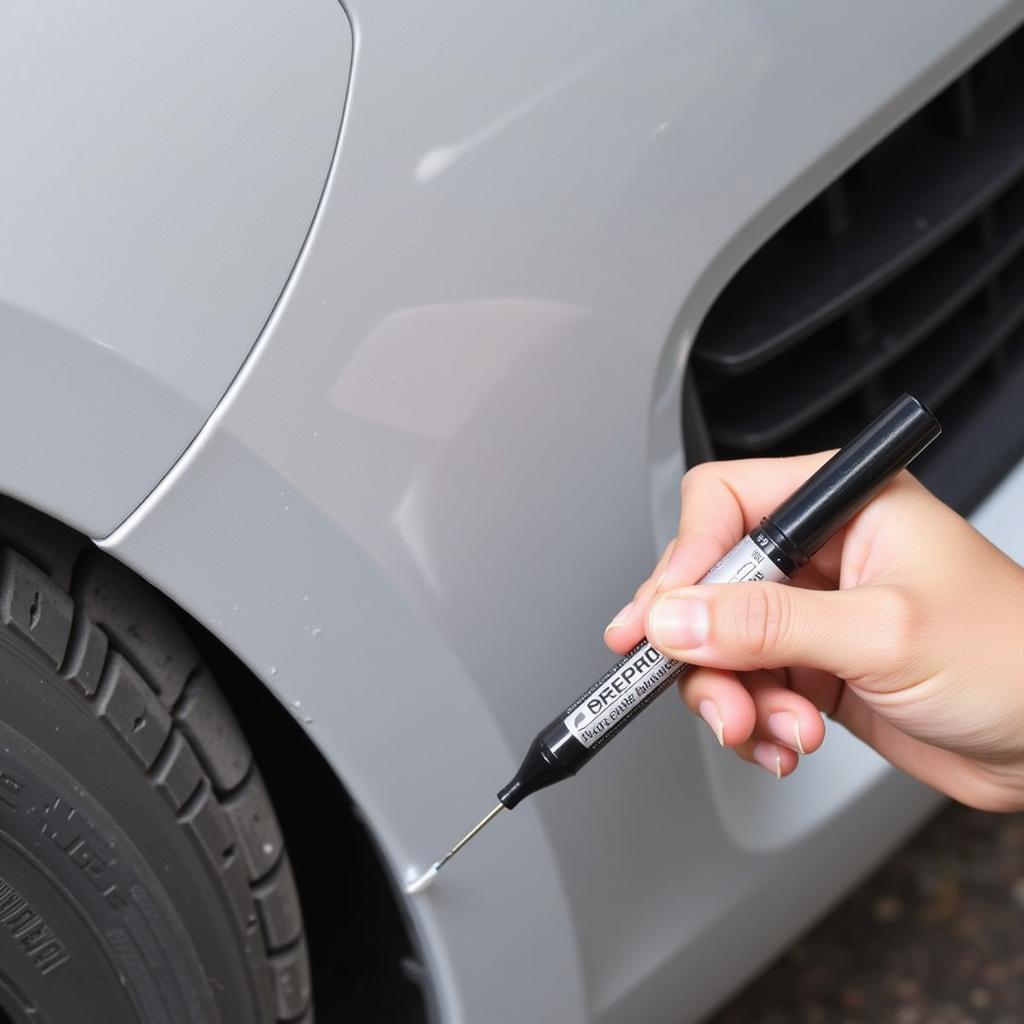Fixing paint chips on your car bumper is more than just a cosmetic concern. Left untreated, these small blemishes can lead to rust and further damage, ultimately impacting the resale value of your vehicle. This guide provides practical steps and professional advice on how to effectively Fix Paint Chips Car Bumper, restoring your car’s appearance and protecting it from future problems.
Addressing minor paint chips early can save you significant money and hassle down the road. best glue for fixing cars offers a convenient and effective solution for various car repairs. This article outlines the necessary tools, materials, and techniques for a successful DIY repair.
Why Fix Paint Chips on Your Car Bumper?
Paint chips expose the underlying metal of your bumper to the elements, making it vulnerable to rust. Rust can spread quickly, causing structural damage and necessitating costly repairs. By addressing paint chips promptly, you prevent rust, maintain the aesthetic appeal of your car, and protect your investment.
How to Identify the Extent of the Damage
Before you begin the repair process, assess the severity of the paint chips. Are they superficial scratches or deep gouges that expose bare metal? This will determine the appropriate repair method. For small, shallow chips, touch-up paint may suffice. Larger, deeper chips require more extensive preparation and possibly filler.
 Assessing Paint Chip Damage on Car Bumper
Assessing Paint Chip Damage on Car Bumper
Materials Needed to Fix Paint Chips on a Car Bumper
Gathering the right materials is crucial for a successful repair. You’ll need:
- Automotive touch-up paint (matched to your car’s color code)
- Primer (if bare metal is exposed)
- Fine-grit sandpaper (2000-3000 grit)
- Rubbing compound
- Car wax
- Masking tape
- Applicators (brushes, toothpicks, or touch-up pens)
- Clean microfiber cloths
- Wax applicator pad
Step-by-Step Guide to Fixing Paint Chips
- Clean the Area: Thoroughly wash and dry the affected area to remove dirt and debris. Use a degreaser if necessary.
- Mask the Surrounding Area: Apply masking tape around the chipped area to protect the surrounding paint.
- Sand the Chip (if necessary): If the chip is deep and exposes bare metal, lightly sand the area with fine-grit sandpaper to create a smooth surface for the primer.
- Apply Primer (if necessary): If bare metal is exposed, apply a thin coat of automotive primer to the chipped area. Allow it to dry completely.
- Apply Touch-Up Paint: Carefully apply thin coats of touch-up paint to the chipped area, allowing each coat to dry before applying the next. Avoid applying too much paint at once, as this can lead to drips and runs.
 Applying Touch-Up Paint to Car Bumper
Applying Touch-Up Paint to Car Bumper
- Level the Paint (if necessary): If the paint builds up higher than the surrounding surface, carefully wet sand the area with fine-grit sandpaper once the paint is completely dry.
- Apply Rubbing Compound: Once the paint is dry and leveled, use rubbing compound to blend the repaired area with the surrounding paint.
- Wax and Polish: Apply car wax to the repaired area and the surrounding area to protect the paint and restore shine.
“A common mistake is applying too much touch-up paint at once,” says John Smith, an automotive repair specialist with over 20 years of experience. “Multiple thin coats are key to achieving a smooth, even finish.”
Preventing Future Paint Chips
While some paint chips are unavoidable, you can take steps to minimize the risk:
- Regular Washing and Waxing: Keeping your car clean and waxed protects the paint from environmental damage.
- Parking Carefully: Avoid parking too close to other vehicles or objects that could scratch your bumper.
- Touch-Up Chips Promptly: Addressing small chips as soon as they appear prevents them from becoming larger and more difficult to repair.
 Car Bumper Paint Chip Prevention Techniques
Car Bumper Paint Chip Prevention Techniques
“Preventive maintenance is always the best approach,” advises Maria Garcia, an automotive paint specialist. “Regular waxing creates a protective barrier against the elements and helps prevent minor scratches from becoming deep chips.”
Conclusion
Fixing paint chips on your car bumper is a manageable DIY project that can save you money and preserve your car’s value. By following the steps outlined in this guide, you can effectively fix paint chips car bumper and prevent further damage. For professional assistance or advice, feel free to connect with AutoTipPro at +1 (641) 206-8880 or visit our office at 500 N St Mary’s St, San Antonio, TX 78205, United States.
 Finished Result of Car Bumper Paint Chip Repair
Finished Result of Car Bumper Paint Chip Repair
Don’t let small paint chips become big problems. Act now to protect your investment and keep your car looking its best. Contact us today for all your car repair needs!





Leave a Reply